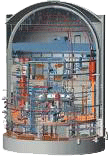Hydrogen recombiners
plagiarism checker for students freeresearch paper for sale
1. Sphere of use
Passive hydrogen autocatalytic recombiners (PHAR) are the system elements reducing hydrogen concentration inside Atomic Power Stations (APS) unit housings.
2. Specifications

2.1. Normative base and classification
PHAR are referred to the second safety class according to NP-001-97 (OPB 88/97), to the group B according to PN AS G-7-008-89 (APM regulations) seismic class NP-031-01-1 Classification mark – 2L
PHAR are the localizing safety system elements. Designing, manufacturing, performance tests, component parts and equipment tests are performed according to the following norms and regulations:
“Equipment and safety equipment operation regulations and regulations of Atomic Power machine pipelines” PN AP G-7-008-89 (APM norms),
“General Atomic Stations safety provisions” NP-001-97 (OPB-88/97)
“Antiseismic AS (atomic stations) designing norms” NP-031-01,
“Strength calculation norms of atomic electric power plant equipment and pipelines” PN AP G-7-002-87
“Equipment and pipelines of atomic power machines. Welding and surfacing. General provisions”, including changes №1 from 1999, PNAE G-7-009-89;
“Equipment and pipelines of atomic power machines. Welding and surfacing. Testing rules” PNAE G-7-010-89;
“Special terms of delivery for equipment, materials, and work-pieces for atomic power engineering”,
“Equipment and APS valves. General technical requirements”, (OTT-87);
2.2. Basic specifications
The hydrogen process of recombination should start at minimum hydrogen volume concentration depending on the steam and gas temperature:
a) no more than 2% at less than 100˚C
b) no more than 1% at more than 100˚C
The process of recombination starts at minimal volume oxygen concentration no less than 2% flameless autocatalytic hydrogen recombination operates under volume hydrogen concentrations from 4% to 95% the time of the PHAR starting operation depending on the steam and water mixture temperature is:
c) no more than 10 minutes at less than 100˚C,
d) no more than 1 min at more than 100˚C.
|
Comparative parameters
|
PHAR types |
||||
|
type №1 |
type №2 |
type №3 |
type №4 |
type №5 |
|
|
Output, g/hr (at P=0,2 MPa, T=373,15 K)К): |
|||||
| — at 3 % H2 |
0,52* |
1,2* |
3,3* |
6,0* |
12,0* |
| — at 5 % H2 |
1,2* |
2,9* |
7,6* |
14,0* |
28,0* |
| — at 8 % H2 |
2,68* |
6,2* |
16,6* |
31,0* |
61,0* |
|
Specific output, kg/ (hr multiple m2) |
|||||
| — at 3 % H2
— at 5 % H2 — at8 % H2 |
13,0* 30,0* 67,0* |
20,0* 48,0* 103,0* |
20,0* 48,0* 103,0* |
25,0* 58,4* 127,8* |
25,0* 58,0* 128,0* |
Converter (housing) is used for directing gas flow through the PHAR from the bottom to the top.
A catalyst module should be a removable cassette, in which there is the material with autocatalytic covering.
The PHAR gas mixtures, containing hydrogen should recombine being in contact with catalysts. Heat evolution during this reaction should decrease gas density in the bottom of a recombiner and simulate convection, providing a lot of oxygen on a catalyst and high coefficient of efficiency.
The autocatalytic covering is hydrophobic and thermostable, that provides effective and long work. The cassette construction allows to take out the material with autocatalytic covering for performing tests.
2.3. PHAR durability requirements:
PHAR are oriented on maximum pressure differential, arising out of various operation modes and Atomic Station accidents. PHAR are oriented on seismic activity during design earthquakes and MRA (maximum rated earthquakes).
2.4. Reliability’s requirements.
The trouble-free life is 8 years. The lifetime of the PHAR is 30 yeas. The lifetime of the PHAR autocatalytic modules is 5 years. The PHAR should be placed under the dome. General maintenance every 5 years. Regenerating time is no more than 50 hr.
2.5. Safety requirements.
General requirements are according to GOST 12.2.003-91, fire safety – GOST 12.1.004-91
2.6. Material requirements
PHAR outside surfaces, it’s component parts and elements are resistant to the process of decontamination. The composition of decontamination fluids is according to the item 3.13 OTT-87 “APS valves for equipment and pipelines. General requirements” Flushing is performed by decontamination fluids of 90 / 95˚С.
| natrium hydroxide (NaOH)- 40 g/l; | potassium permanganate (KMnO4) — 5 g/l. |
Composition №2
| sorrel acid (H2C2O4) — 30 g/l; | hydrogen peroxide (H2O2) — 0,5 g/l. |
Hydrogen peroxide can be replaced by hydrogen nitrate (НNО3) -1,0 g/l. Cycle time – no more than 10 hr per one fluid.
Frequency – once a year.
Distillate cleaning should be carried out after every cycle. If material is carbon steel, such details should be covered with polymeric and protecting coatings – GOST R51102-97.
Materials, half-finished parts, components and purchased parts applied for PHAR manufacturing and maintenance, have enterprise-supplier documents which proves its delivery goes according to federal standards regulations or technical conditions.
2.7. I&C requirements
PHAR is the element, demanding no supervision over its operational process.








